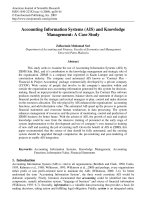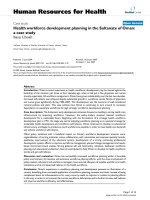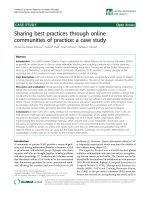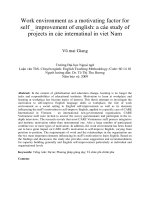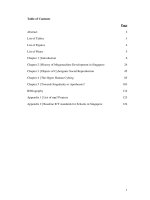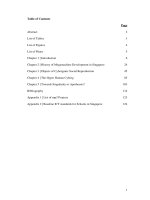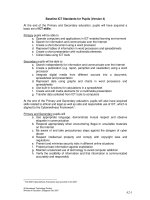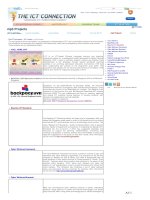ACCOUNTING FINANCE LESSONS OF NRON a case study harold bierman
Bạn đang xem bản rút gọn của tài liệu. Xem và tải ngay bản đầy đủ của tài liệu tại đây (2.51 MB, 215 trang )
ACCOUNTING/
FINANCE
LESSONS OF
NRON
A Case Study
March 25, 2008
b591
fm
FA
This page intentionally left blank
ACCOUNTING/
FINANCE
LESSONS OF
NRON
A Case Study
Harold Bierman, Jr.
Cornell University, USA
World Scientific
NEW J ERSEY
. LONDON
. SINGAPORE
. BE I J ING . SHAN GHAI . H ONG KONG
. TAIPEI .
CHENNAI
Published by
World Scientific Publishing Co. Pte. Ltd.
5 Toh Tuck Link, Singapore 596224
USA office: 27 Warren Street, Suite 401-402, Hackensack, NJ 07601
UK office: 57 Shelton Street, Covent Garden, London WC2H 9HE
British Library Cataloguing-in-Publication Data
A catalogue record for this book is available from the British Library.
ACCOUNTING/FINANCE LESSONS OF ENRON
A Case Study
Copyright © 2008 by World Scientific Publishing Co. Pte. Ltd.
All rights reserved. This book, or parts thereof, may not be reproduced in any form or by any means,
electronic or mechanical, including photocopying, recording or any information storage and retrieval
system now known or to be invented, without written permission from the Publisher.
For photocopying of material in this volume, please pay a copying fee through the Copyright
Clearance Center, Inc., 222 Rosewood Drive, Danvers, MA 01923, USA. In this case permission to
photocopy is not required from the publisher.
ISBN-13 978-981-279-030-9
ISBN-10 981-279-030-6
Typeset by Stallion Press
Email:
Printed in Singapore.
Sandhya - Accounting_finance.pmd
1
3/31/2008, 2:22 PM
March 25, 2008
b591
fm
FA
Contents
Introduction
vii
Acknowledgments
ix
1
The Enron Success and Failure
1
2
Enron as of 31 December 2000
12
3
First Six Months of 2001: Before the Storm
31
4
Sherron Watkins’ Letter to Kenneth L. Lay
41
5
The Clouds Burst
51
6
The 100-Year Flood
63
7
JEDI and Chewco: Not the Movie
69
8
LJM1 and Rhythms
85
9
LJM2 and Raptors I and III
98
10
LJM2 and Raptors II and IV
115
11
Other Transactions
122
v
March 25, 2008
b591
vi
fm
FA
Accounting/Finance Lessons of Enron: A Case Study
12
The Collapse
128
13
The Indictment of Lay and Skilling
147
14
The Trial
151
15
A Slice of the Skilling–Lay Trial
167
16
The Skilling–Lay Trial: Fair or Foul?
174
17
Mark to Market Accounting: Feeding the Growth
Requirement
180
Concluding Observations
189
18
Index
201
March 25, 2008
b591
fm
FA
Introduction
There is a major problem in writing this book. To tell the story fairly,
a very large number of complexities must be explained. For example,
Chapter 2 discusses Enron’s Year 2000 Annual Report. It is difficult
to study that report and conclude that the firm is heading toward
collapse. On the other hand, it is not difficult to identify footnotes that
are vague and incomplete (of course, the author also has the benefit
of hindsight).
Why write a casebook describing and evaluating events about
which there have been criminal trials and extensive hearings?
First, we should review what a manager or financial analyst should
have known about Enron based on publicly available accounting
information. Second, the Powers Report (William Powers was the
Chairman of the Special Investigation Committee of the Enron Board
of Directors) provides us with a good foundation for understanding
the accounting and financial decisions that contributed to Enron’s collapse. Third, the Skilling–Lay Trial enables us to determine the worst
aspects of Enron’s actions, and gives us a chance to evaluate the Government’s conduct of that trial.
To determine whether or not the Skilling–Lay trial was fair, it is
important that we understand why the seventh largest US Corporation collapsed in 2001. Why did a profitable corporation with an
apparently strong balance sheet go from a firm with profitable growth
vii
March 25, 2008
viii
b591
fm
FA
Accounting/Finance Lessons of Enron: A Case Study
prospects to a bankrupt shell in a matter of less than 8 weeks (from
mid-October to mid-December 2001)?
Even after restarting the accounting incomes of 1997–2001 in
October 2001, Enron made over $2 billion of net income over that
four-year period. The accounting results of operations do not, by
themselves, lead to a forecast of financial insolvency.
I have tried to explain the accounting and financial complexities
of Enron and the Skilling–Lay trial as clearly as I could. But unfortunately, considerable complexity and confusion still remain. You
should ask yourself — to what extent the accounting and financial
complexities were likely to have been understood by Enron’s senior
management, by financial analysts, and by the Skilling–Lay jury? Also,
were Skilling and Lay given a fair trial? Should the objective of the
US Attorneys be to gain convictions or to seek justice? Does it matter
to the society how a conviction is obtained?
One obvious conclusion to most readers would be that there
should have been more effective limits placed on the complexity and
opaqueness of the financial transactions and the accounting reports
by Enron’s top management. It would seem that by 1997, few if any
managers or members of the Board of Directors at Enron truly and
fully understood the financial transactions and the accounting implications as well as the legal aspects of those transactions. There should
have been better accounting disclosures, but equally important Enron
management should have made better financial decisions.
I hope this book will enlighten a wide range of readers including
those who are not accounting–finance experts. It is also designed to be
used in either an advanced accounting or finance college course as a
supplement or the core component of a course. Enron supplies many
useful lessons. The collapse need not have happened.
Harold Bierman, Jr.
Cornell University
Ithaca, New York
March 25, 2008
b591
fm
FA
Acknowledgments
My friends and colleagues, Ed. Altman, Dick Conway, Bob Frank,
Jerry Hass, and Sy Smidt read early drafts and parts of this manuscript
and rectified many errors.
Don Schnedeker, head librarian of the Johnson School supplied
ready and cheerful assistance.
Barb Drake cheerfully typed many drafts.
Thanks to all of them mentioned above and many others.
ix
This page intentionally left blank
March 25, 2008
b591
ch01
FA
Chapter 1
The Enron Success and Failure
In 1984, Kenneth L. Lay became the Chief Executive Officer of
Houston Natural Gas Corporation, a pipeline operator. Soon after he
took position, his firm merged with Internorth, another pipeline company. Lay became the CEO of the merged firm, and the name of the
firm was changed to Enron. As deregulation of energy became more
widespread (Lay influenced the rate of change) the mission of Enron
widened to include the trading of energy contracts.
Shortly after the merger with Internorth, Lay hired the consulting firm, McKinsey & Co., to help develop a business strategy for
Enron. One of the consultants assigned to the Enron study was Jeffrey Skilling. Lay subsequently hired Skilling to develop new business activities for Enron. Skilling successfully launched Enron’s highly
profitable business of trading energy derivatives.
Andrew Fastow was hired by Enron in 1990 from Continental Illinois Bank in Chicago and was appointed Chief Financial
Officer (CFO) of Enron in 1998. Fastow was thought to complement Skilling’s interests and abilities. Appointing Fastow as CFO was
Enron’s second biggest mistake (it probably would not have been
made if the first mistake of allowing the departure of Rich Kinder had
not been made).
1
March 25, 2008
b591
2
ch01
FA
Accounting/Finance Lessons of Enron: A Case Study
Rich Kinder
In November 1996, Enron announced that Rich Kinder was leaving Enron. Shortly before that announcement the Enron Board of
Directors (and Ken Lay) had failed to appoint Kinder as the CEO.
The decision not to appoint Kinder as the President of Enron had very
little to do with Kinder’s acknowledged managerial abilities.
Kinder was (and is) a world-class manager, one of the few effective
hands-on managers at Enron. The departure of Kinder was the most
significant negative event for Enron during the 1990s. It would likely
have been a different firm in 2001 if he had stayed.
When he left, Kinder bought from Enron the Liquids Pipeline
Division for $40 million. With Bill Morgan and the $40 million
pipeline he formed Kinder Morgan Corporation.
Kinder Morgan went public, but in 2006 Kinder and Morgan took
the firm private (the corporation had a market cap of $14 billion).
In 2006, Rich Kinder was one of the world’s richest persons and
will be even richer when Kinder Morgan goes public again.
The $14 billion of Kinder Morgan value could possibly have been
value-added to Enron if Kinder had not been rejected as CEO. Enron
needed effective managers of real assets, and Kinder was among
the best.
John Wing
John Wing was another great manager (of power plants) who was
shown the door by Enron in July 1991. He helped execute the original
deal that created Enron and was in and out of Enron from the early1980s to 1991. He made money for Enron with hard assets.
His biggest moneymaker for Enron was a power plant in England
called Teesside. He also did many other profitable deals for Enron.
John Wing did not fit easily into the Enron management structure.
He was not the type of person with whom Ken Lay felt comfortable.
When Wing wanted to separate his power group from Enron and form
a separate publicly owned corporation, Lay facilitated his departure
from Enron.
March 25, 2008
b591
ch01
FA
The Enron Success and Failure
3
It is interesting to conject what would have happened if Enron had
financed Rich Kinder’s gas pipeline company and John Wing’s power
company. These two entities certainly would have developed into two
very interesting merchant assets.
The Year 2001
In the year 2001, Enron was the seventh largest US Corporation (based
on revenues) and possibly would have been ranked larger if the revenues of all the subsidiaries and special-purpose entities (SPEs) were
factored into the calculation. It would have been ranked much lower if
trading transactions were not treated as revenue. Interestingly, Enron
was ranked number five in the Fortune 500 listing for 2001, published
in March 2002. But no matter where we exactly rank it, Enron was
a large profitable corporation before October 2001. If we consider
only the available public information as of August 2001, it was a very
profitable corporation.
On 17 December 2001, the Enron Corporation filed an 8-K report
with the Securities and Exchange Commission (SEC). It stated that
on “December 2, 2001, Enron Corp. (the “Company”) and certain
other subsidiaries of the Company (collectively, the “Debtors”) each
filed voluntary petitions for relief under chapter 11 of title 11 of the
United States Code (the “Bankruptcy Code”) in the United States
Bankruptcy Court for the Southern District of New York…”
Thus, in December 2001, Enron filed for bankruptcy. How did
a seemingly healthy, profitable corporation transform itself into the
biggest corporate scandal of the new millennium?
The newspapers have reported extensively on the clienteles that
have been harmed by the Enron collapse. These include:
Employees with 401-K plans heavily (or exclusively) invested in
Enron stock;
Employees who have lost their jobs at Enron;
Employees and investors who held worthless Enron stock;
Debtholders who owned debt that had lost most of its value
(including bank debt).
March 25, 2008
4
b591
ch01
FA
Accounting/Finance Lessons of Enron: A Case Study
But, the list of those affected greatly is much longer, including:
Top management with reputations in shatters and significant
reductions in wealth.
Arthur Anderson — A once highly respected public accounting
firm was struggling to stay afloat and subsequently was forced to
shut down operations.
Security analysts who recommended Enron stock.
Bond rating agencies who had imperfect crystal balls.
Politicians who accepted donations from Enron.
At the beginning of 2001, Enron’s common stock was high compared to its earnings. How does a CEO manage a company whose
stock is overvalued? Enron management chose to take actions that
presented a sunny smile to the public while painful events occurred.
There were some executives who, fooled by the firm’s own accounting
and financial tricks, actually thought things were bright.
Five Business Segments
Enron was divided into five different specific business segments and a
sixth general unit (catch-all).
1. Transportation and Distribution. This segment included regulated
industries (e.g., electric utility operations), interstate transmission
of natural gas, and the management and operation of pipelines.
2. Wholesale Services. This included a large portion of Enron’s trading operations, energy commodity sales and services, and financial
services of wholesale customers, and the development and operation of energy-related assets (such as power plants and natural gas
pipelines).
3. Retail Energy Services (Enron Energy Services or EES). Sales of
energy-related products (including expertise) to end-use customers
(including commercial and industrial firms). On 30 June 2001,
Enron had 730,000 retail customers.
March 25, 2008
b591
ch01
FA
The Enron Success and Failure
5
4. Broadband Services. Construction and management of fiber-optic
networks; the marketing and management of bandwidth; trading
bandwith.
5. Exploration and Production. Exploration and production of natural gas and crude oil.
6. The catch-all segment. This included water and renewable energy;
the supply of water and energy to end-use customers, the provision of wastewater services; construction and operation of windgenerated power projects.
The Retail Energy Services and Broadband Services were the two
primary problem areas identified by the US Attorneys prosecuting
Skilling and Lay.
The Three Components
While Enron was organized into five business segments and a sixth
catch-all segment, it is useful in analyzing its collapse to describe
Enron as consisting of three basic components:
1. A trading unit;
2. Real assets (generating and transportation);
3. Merchant assets (ownership interests in other firms).
While the initial investment in the merchant assets was less than
that in the other two components, it was transactions related to the
merchant assets that contributed most significantly to Enron’s collapse
and to Arthur Andersen’s audit difficulties.
Interestingly, the problems associated with merchant assets were
created not by Enron making bad merchant asset investments, but
rather by the too-clever and too-imperfect efforts to insure that gains
in the value of merchant assets that had been achieved were then
not lost by value decreases. The objective of hedging the gains was
reasonable. The means chosen to achieve the objective by the CFO
Andrew Fastow were far from reasonable.
March 25, 2008
6
b591
ch01
FA
Accounting/Finance Lessons of Enron: A Case Study
The Enron Hedge Fund
There was a hedge fund (ECT Investments) within Enron that invested
in energy stocks. Investments were not limited to energy stocks, but the
large gains were made on energy and technology stocks. The operation
started small but grew to $150 million of Enron equity, and there were
about $3 of debt for each dollar of equity. The fund earned annual
returns of more than 20% (Wall Street Journal, 11 April 2002). We
do not know if the profits continued after the stock market retreated
in 2001.
The investing community was not at all aware of the hedge fund
operations. Given the large amount of debt frequently used by hedge
funds, knowledge of the existence of the fund could upset the conservative common stock investors. On the other hand, the fund offered
an investment opportunity (a hedge fund) that was not normally available to investors with small amounts of capital. The hedge fund’s
income amounted to as much as 10% of Enron’s earnings in some
years.
There is no reason to conclude that the Enron hedge fund was a
material contributing factor to the collapse if this fund is separate
from the merchant assets that were reported.
A Distraction
The 11 March 2002 issue of Newsweek contains an article titled
“Enron’s Dirty Laundry” in which it described “sex-drenched outof-control corporate culture that ultimately wrecked the company”.
Enron’s managerial culture likely contributed to the firm’s collapse
but in this book let us leave the subject of sex and other cultural considerations with that conclusion. For more details, The Smartest Guys
in the Room: The Amazing Rise and Scandalous Fall of Enron, can be
referred to. This is an excellent comprehensive investigation into the
events leading to Enron’s collapse. In the current book, we will focus
on the accounting and finance issues that resulted in Enron’s collapse.
Among the titles considered for this book was “Enron: The Dumbest Guys in the Room”, but to be fair, the participants were not dumb.
March 25, 2008
b591
ch01
FA
The Enron Success and Failure
7
However, they were not the smartest, and sometimes they were too
smart.
Rush to Judgment
In the fall of 2001 and in the winter of 2002, newspapers quickly
identified the fact that Enron and the system that Enron operated
in were corrupt. Paul Krugman had no problem identifying Enron’s
corruption (The New York Times, 18 January 2002, p. A23).
The Enron debacle is not just the story of a company
that failed; it is the story of a system that failed. And the
system didn’t fail through carelessness or laziness; it was
corrupted…
So capitalism as we know it depends on a set of institutions — many of them provided by the government —
that limit the potential for insider abuse. These institutions
include modern accounting rules, independent auditors,
securities and financial market regulation, and prohibitions against insider trading.
The Enron affair shows that these institutions have been
corrupted. None of the checks and balances that were supposed to prevent insider abuses worked; the supposedly
independent players were compromised.
The truth is that key institutions that underpin our economic system have been corrupted. The only question that
remains is how far and how high the corruption extends.
Is “corruption” an accurate and fair description of Enron’s activities?
Bob Herbert (The New York Times, 17 January 2002, p. A29) saw
the Enron debacle as an opportunity to attack deregulation:
The kind of madness that went on at Enron could only
have flourished in the dark. Arthur Andersen was supposed to have been looking at the books, but the vast
shadows cast by the ideology of deregulation allowed that
March 25, 2008
8
b591
ch01
FA
Accounting/Finance Lessons of Enron: A Case Study
company to escape effective scrutiny as well. So you have
revolving-door abuses and pernicious financial arrangements between companies like Enron and auditors like
Andersen that are similar to those between private companies.
There is also the observation of Senator Peter G. Fitzgerald of
Illinois:
Mr. Lay is perhaps the most accomplished confident man
since Charles Ponzi.
(The New York Times, 17 February 2002, p. 52)
Are the observers fair in reaching the above conclusions? Was Lay
a confident man when compared to Charles Ponzi? Could Lay receive
a fair trial given the press coverage?
The Activities of Kenneth L. Lay
The 4 February 2002 issue of Newsweek had an article on Lay. For
the purposes of this book, the pictures accompanying the text are most
significant since they give us some insight how he spent his time as the
top manager of Enron.
a. Lay with George and Barbara Bush at an economic summit.
b. Lay with Phil and Wendy Gramm (at the 1992 Republican Convention). Phil was a US Senator.
c. Lay golfing with Bill Clinton, Gerald Ford, and Jack Nicholas.
d. Lay with George W. Bush.
e. Lay with Clyde Drexler and Rudy Tomjanovich (one-time basketball luminaries).
f. Lay receiving an award from the Wildlife Conservation Society.
g. Lay with Mikhail Gorbachev.
h. Lay on vacation.
While these pictures prove little, they do indicate that Lay took his
public relations responsibilities seriously. There is little evidence to
date (including the 2006 trial) that he was a “confident man” when
March 25, 2008
b591
ch01
FA
The Enron Success and Failure
9
compared to Charles Ponzi. There is some evidence to show that he did
not pay attention to the details of the management, because of which
he failed to perform properly as CEO. This is particularly valid since
the “details” of Enron were material and affected its very existence.
The Path of the Enron Stock Price
In August 2000, the Enron common stock sold in excess of $90 per
share. In January and February 2001 it was still sold in excess of $80.
This was a P/E of 66 based on trailing basic earnings per share of
$1.22 for 2000.
By August 2001 the stock price had fallen to below $40. Even after
the earnings and stock equity revisions were announced on October
16 and 17, the stock still sold for $20 (as late as October 23).
By November 30, the stock price was $0.26 per share and on 15
January 2002, the stock was suspended from trading on the New York
Stock Exchange.
The Indictment
The Grand Jury indictment of Skilling and Lay included the following
(p. 3, Section 5).
5. As detailed below, defendants KENNETH L. LAY
(“LAY”), JEFFREY K. SKILLING (“SKILLING”), and
their conspirators, engaged in a wide-ranging scheme to
deceive the investing public, including Enron’s shareholders, the SEC, and others (use “Victims”), about the true
performance of Enron’s businesses by: (a) manipulating
Enron’s publicly reported financial results; and (b) making public statements and representations about Enron’s
financial performance and results that were false and misleading in that they did not fairly and accurately reflect
Enron’s actual financial condition and performance, and
they omitted to disclose facts necessary to make those
statements and representations fair and accurate.
March 25, 2008
b591
10
ch01
FA
Accounting/Finance Lessons of Enron: A Case Study
The indictment concluded that the conspiracy’s objectives included
(paragraph 17).
• Reporting recurring earnings that falsely appeared to grow
smoothly by approximately 15 to 20 percent annually and thus
create the illusion that Enron met or exceeded the published expectations of securities analysts forecasting Enron’s reported earningsper-share and other results;
• Touting falsely the success of Enron’s business units;
• Concealing large losses, “write-downs,” and other negative information concerning its business units;
• Masking the true magnitude of debt and other obligations required
to keep the company’s varied and often unsuccessful business ventures afloat;
• Deceiving credit rating agencies in order to maintain an investmentgrade credit rating; and
• Artificially inflating the share price of Enron’s stock, including
attempting to stem the decline of Enron’s share price in 2001.
If true, these are bad actions, but none of the above, by themselves,
are likely to cause the bankruptcy of a healthy corporation. But Enron
was to a large extent a trading corporation, and the bad press in the
fall of 2001 led to the loss of its trading partners and financing.
Conclusions
This book will investigate the factors leading to Enron’s collapse and
try to separate out the significant from the less significant. We shall see
that there were real factors contributing to the collapse and that there
were intangibles that eroded the market’s faith in Enron’s accounting
and business practices, and created the “run on the bank” that was
described by Jeffrey Skilling (ex-CEO of Enron).
The objective of Chapters 2 and 3 is to establish that there were no
sufficient reasons for a casual reader of Enron’s published financial
statements to conclude that this was a financially distressed corporation. Chapter 4 starts the explanation of the fall.
March 25, 2008
b591
ch01
FA
The Enron Success and Failure
11
The book will also review elements of the 2006 Skilling–Lay trial.
The objective is not to determine the innocence or guilt of the two
men. Rather, it is to dissect the accusations and testimony so that some
of the fluff can be cast aside, and it can be better determined whether
the Skilling–Lay trial was fair or not. The two men should not have
been convicted because investors lost money when Enron collapsed,
but the bankruptcy of Enron looms large as a primary factor in their
convictions. At least there is reason to think that the Judge and the
US Attorneys thought it was very important.
The position of this book’s author is that Enron (Skilling and Lay)
could have presented more and better financial information to the
public. But the US Attorneys also distorted the facts and arguments
during the Skilling–Lay 2006 trial at a level that was comparable to the
accounting distortions of Enron. The US Attorneys “knew” Skilling
and Lay were guilty and used strategies to gain convictions, given their
guilt.
It is interesting to note that four of the most significant events
leading to Enron’s bankruptcy did not give rise to immediate accounting entries. These events were (1) hiring of Fastow; (2) departure of
Kinder and Wing from Enron; (3) giving of Marks a relatively free
hand to make international investments; (4) shift of mark to marketing accounting.
Reference
McLean, B and P Elkind (2003). The Smartest Guys in the Room: The
Amazing Rise and Scandalous Fall of Enron. New York, NY: Portfolio
(the Penguin Group).
March 25, 2008
b591
ch02
FA
Chapter 2
Enron as of 31 December 2000∗
Assume financial analysts were limited to using the year 2000 annual
report of Enron to evaluate the financial affairs of the company. Of
course, financial analysts should use information beyond the publicly
available financial information if they can legally obtain it. In this
chapter we analyze Enron’s likelihood of bankruptcy using only its
year 2000 annual report.
At what stage should the security analysts have recognized that
things were not well with Enron? Let us review the year 2000 annual
report of Enron. First consider the net incomes and earnings on common stock for the years 1998–2000.
Year
Earnings on
common stock∗
Net income∗
1998
1999
2000
686 million
827
896
703 million
893
979
∗ p. 31 of the annual report.
∗ All page references in this chapter are to Enron’s year 2000 annual report or to the Skilling–Lay
trial proceedings unless otherwise indicated.
12
March 25, 2008
b591
ch02
FA
Enron as of 31 December 2000
13
Both the $896 and $979 million earnings for the year 2000 are after
a $326 million charge to reflect the decrease in the value of the Azurix
investment. In addition, there is a $39 million gain on The New Power
Company (TNPC) stock. This gain on the TNPC investment will be
important in later discussions because Enron has taken inappropriate
steps to protect that gain.
Enron reported that it earned a total of $2409 million on common
stock from 1998 to 2000, with the earnings increasing each year.
There were reasons for its stock price to become “high” (but not as
high as it went). A reader of the annual report may readily conclude
that the Enron stock price was too high without concluding that Enron
was heading toward bankruptcy.
Azurix
The $326 million write-down of the Azurix investment reported in
the annual report is important for several reasons. First, it reflected a
bad investment (or a badly run investment) of Enron. In July 1998,
Enron purchased Wessex Water Company for an amount equal to
$1.9 billion to $2.2 billion, approximately a 28% premium over the
Wessex stock price. This purchase premium was difficult to recover
given the unfriendly regulatory climate in England (Wessex was a
small English water and sewage company). Second, the accounting
for Azurix figured significantly in the Skilling–Lay trial.
Reberra Mark, who had been in charge of Enron’s international
trust, was in charge of Azurix. The goal was to use Wessex as a base to
launch a worldwide water distribution and water treatment company.
In addition to the company in England, Azurix operated in Mexico,
Canada, and Argentina. Each acquisition was purchased at premium
prices reflecting Mark’s optimism that the water business represented
large profitable business opportunities. Thus at the very instant of
acquisition, the water assets were recorded at costs materially larger
than their expected fair values. (The costs were the prices paid for the
assets.) Mark’s hope was that the assets were worth more than the
fair value to Enron.
March 25, 2008
b591
14
ch02
FA
Accounting/Finance Lessons of Enron: A Case Study
While the purchase of these assets at inflated prices might have
been managed badly and reflected bad business judgments, there was
no criminal intent in their purchase and initial accounting (as any
observer would agree).
For more details of Enron’s attempts to form a worldwide water
business, see Fox (2003) or McLean and Elkind (2003).
The Trial
Ms Ruemmler states (p. 17694):
Mr. Lay and Mr. Skilling had been unable to sell $10
billion or so in international assets that were dragging
the company down. Mr. Skilling had estimated that those
assets were worth only about half of what they were being
carried on Enron’s books for. An expensive venture into
Enron’s — into the water business — you heard about
this — Azurix was just a colossal disaster.
Remember that the water business was acquired by Mark, Skilling,
and Lay at premium prices in 1998–1999. Azurix went public in 1999
at $19 a share. Skilling was not a supporter of Mark’s efforts to build
an international water empire. His valuation of the acquired assets
was likely to be conservative.
It is not surprising that Enron management was not willing to
concede defeat two years later. But Ms Ruemmler sees the refusal to
write the assets down differently (p. 17820):
They could not afford to take the $700 million Wessex
goodwill loss that they needed to take, so they had to come
up with a scheme to avoid that.
The most powerful motive in the world to come up with
a scheme to defraud Arthur Andersen is if you know that
if you take a bigger loss, that it’s going to mean certain
death for the company because a credit downgrade will
ensue.


